
New WHO data shows violence against women and girls remains alarmingly widespread. Nearly 1 in 3 women globally have faced intimate partner or sexual violence in their lifetime — a figure that has barely changed since 2000.
➡️ bit.ly/3M46heI
@whowpro.bsky.social
World Health Organization @WHO.int in the Western #Pacific Region, home to 1.9B people in #Asia & #Oceania.

New WHO data shows violence against women and girls remains alarmingly widespread. Nearly 1 in 3 women globally have faced intimate partner or sexual violence in their lifetime — a figure that has barely changed since 2000.
➡️ bit.ly/3M46heI

A photo collage of a doctor, a farmer, a vet holding a goat and a young woman Antimicrobial resistance can be stopped . We all have a role to play
#AntimicrobialResistance is a global health crisis that requires collective action 💪
Everyone has a role to play in keeping us all safe and helping #StopDrugResistance - whether you’re a health worker, farmer, government worker, or individual advocate.
#WorldAntimicrobialAwarenessWeek

Eliminate cervical cancer: vaccinate, screen, treat
✅Get informed
✅Get screened
✅Get vaccinated
#CervicalCancer can be prevented and treated, if caught early.
Learn more: bit.ly/47GIbzd

Fingers in the heart sign with text that says every action counts 90/70/90 by 2030. End cervical cancer
It's World #CervicalCancer Elimination Day.
Cervical cancer could be the first cancer EVER in the world to be eliminated, if:
9️⃣0️⃣% of girls are vaccinated
7️⃣0️⃣% of women are screened
9️⃣0️⃣% of women with cervical cancer receive treatment

Health workers in Cambodia in a camp for displaced people due to a border conflict with Thailand
This initiative will enable service workers to integrate mental health care into emergency services and better support their communities in recovery. 💚
#MentalHealthMatters
#HealthforAll
📷 WHO / Monika Mey

A girl holding a ball while lying on a hammock
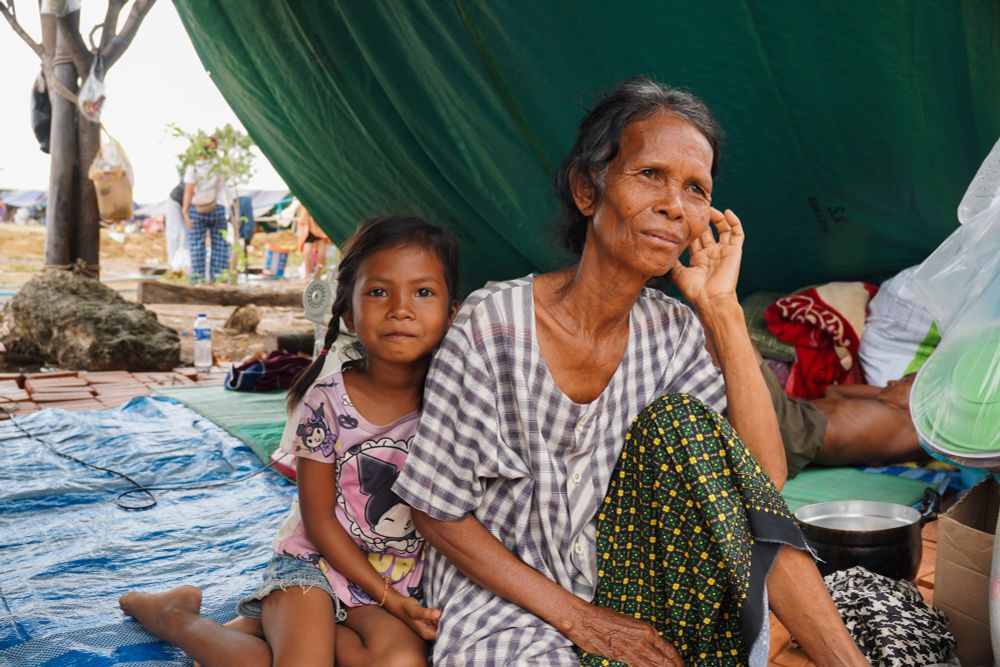
An older woman and a girl in a camp for displaced people in Cambodia
In #Cambodia, WHO is working with the Ministry of Health to train frontline health care workers on psychological first aid and trauma counselling across three provinces where communities were heavily impacted by the border conflict.
16.11.2025 04:07 — 👍 0 🔁 0 💬 1 📌 0
Women and children in a camp for displaced people in Cambodia
#MentalHealth should be part of every response – before, during and after a crisis.
📷 WHO / Monika Mey

Learn more 👇
www.who.int/westernpacif...

A father and mother each hold a baby in the Kangaroo Mother Care embrace

A mother holds her baby to her chest

A health worker hands a baby to her mother
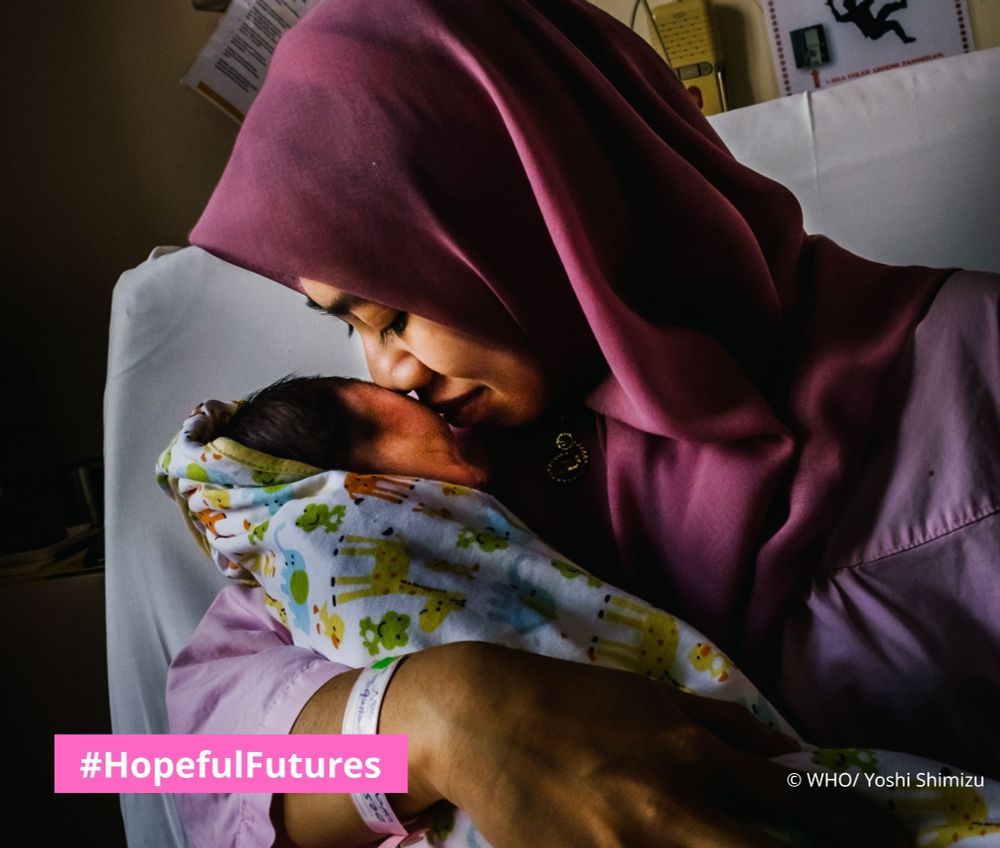
A mother kisses her baby on the forehead
Today is #WorldPrematurityDay 💜
Globally, 1 in 10 babies is born too soon – before 37 weeks of pregnancy - and complications relating to prematurity are the leading cause of child deaths.

A quote from Dr Huong Thi Giang Tran, Director of Programmes for Disease Control at the WHO Western Pacific Region, which says I wish to sincerely thank all Member States and partners for their commitment towards achieving and maintaining polio-free status...working tirelessly to ensure that polio is no longer a devastating burden on their children and the whole society.
"Sustaining #polio-free status in the Region must remain a central pillar, requiring strong leadership, vigilant surveillance systems, and continued commitment with a comprehensive and ongoing strategy." - Dr Huong Thi Giang Tran, WHO Western Pacific
13.11.2025 11:26 — 👍 1 🔁 0 💬 0 📌 0Ending #polio isn’t just a goal, it’s a promise to children everywhere.
Here’s what you need to know and what you can do to #EndPolio. 👇
Read WHO Regional Director Dr Saia Ma'u Piukala's complete remarks at the 31st RCC meeting: bit.ly/499nT2q
bsky.app/profile/did:...
That historic declaration was made in Japan during the 6th meeting of the Regional Commission for the Certification (RCC) of Poliomyelitis Eradication in the Western Pacific in 2000.
This week, the 31st RCC meeting also takes place in Japan to mark this momentous occasion. #EndPolio

A quote from WHO Regional Director Dr Saia Ma'u Piukala that says one shared goal united us: to eradicate poliomyelitis and protect every child from this devastating disease - giving them the chance to live healthy, productive lives.
Today, we celebrate a remarkable milestone: 25 years since the Western Pacific Region was declared free of indigenous wild poliovirus. 👏👏👏
12.11.2025 06:17 — 👍 4 🔁 0 💬 1 📌 1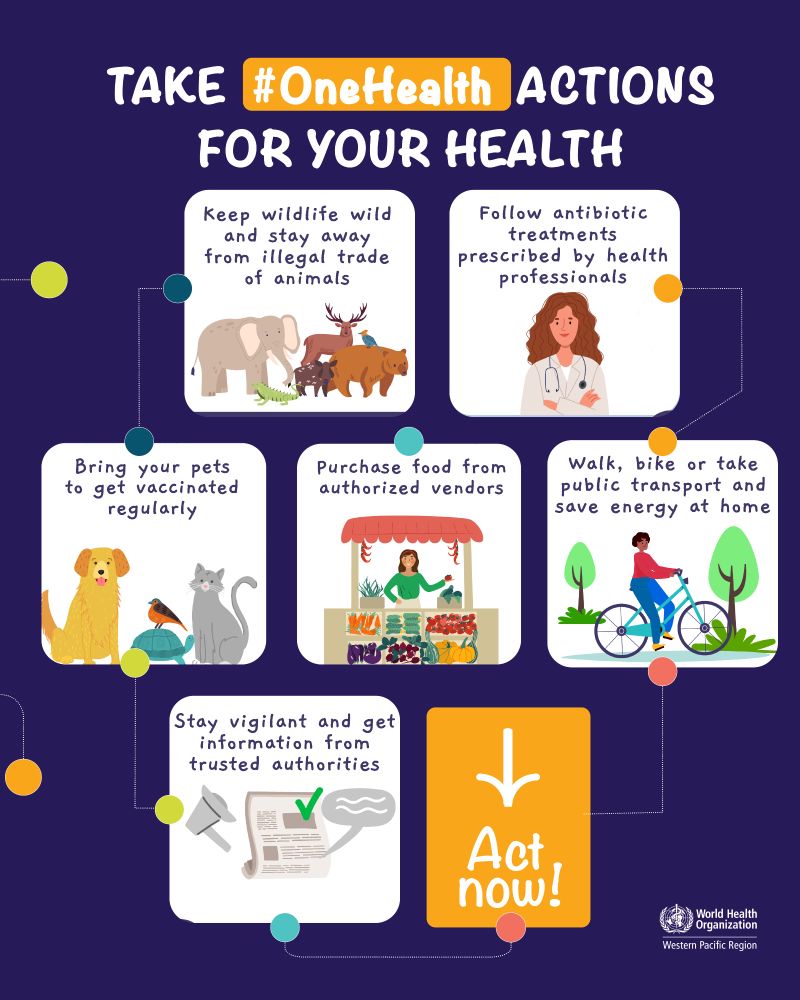
Illustrations of One Health actions people can take for their health, including walking biking taking public transport, bringing pets to get vaccinated regularly, purchasing food from authorized vendors, following antibiotic treatments prescribed by health professionals, keeping wildlife wild and staying away from illegal trade of animals, staying vigilant and getting information from trusted authorities
Support & promote #OneHealth:
🐅 Help wildlife stay wild. No illegal wildlife trading
💊 Follow & complete antibiotic treatments as prescribed by health professionals
🐱 Vaccinate your pets to prevent diseases
🐔 Practice #FoodSafety measures
⚡ Consume energy sustainably
ℹ️ Get info from trusted sources

Dots of different colours connected by lines. Text says human health does not exist in a vacuum

Line illustrations of humans, animals, plants. Text says it is interlinked with the health of animals and the planet

Line illustrations of animals with text that says 75% of new or emerging human diseases have come from animals

Illustrations of animals and plants on top of a half-circle with illustrations of windmills, city buildings in the distance, green hills, a road with a red car, trees. Text says to protect our health, we must also protect the health of animals plants and the environment. The One Health approach brings us to work all together for a healthier world
It's #OneHealthDay.
To protect our health, we must also protect the health of animals, plants and the environment.
The #OneHealth approach brings us all to work together for a healthier world.
One Health helps address crucial health issues of our time. It is a lifestyle, a way of living.
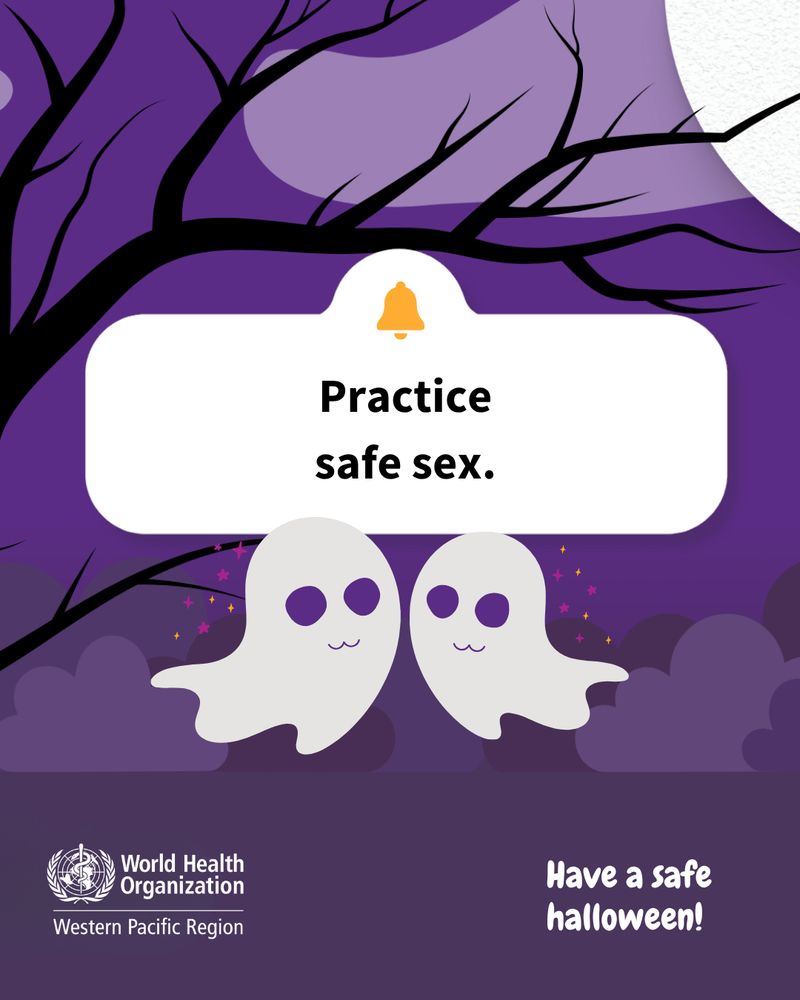
Halloween illustrations with two white ghosts in the middle. Text says pratice safe sex
If you don’t end up ghosted this #Halloween, remember to:
🔹Practice #SafeSex
🔹Use condoms
🔹Look after your sexual health

Silhouette illustration of an individual with a black hat riding a broomstick. Text says don't drink and drive. Have a safe halloween
Watch out for low-flying bats this #Halloween and keep safe on the road!
#RoadSafety tips:
✅Stay within the speed limit.
✅Wear helmets and seatbelts.
✅Stay focused.
❌No distracted driving.
❌Do not drink and drive. #AlcoholLeavesAMark

#BreastCancer is the most common cancer among women in Samoa. Unfortunately, many women are diagnosed late, but early detection can save lives.
Here are 5️⃣ things every woman in Samoa should know about breast cancer 👇
#BreastCancerAwarenessMonth
www.who.int/westernpacif...

Learn more in our news story 👇
www.who.int/westernpacif...
From cancer to crashes to violence – alcohol harms reach far beyond the glass.
Watch and share.
#RegulateAlcoholNow
#AlcoholLeavesAMark

A public health infographic from the World Health Organization, Western Pacific Region, titled ‘Protect yourself and others from respiratory illnesses.’ It lists eight preventive measures with icons: Get the flu shot, cover coughs and sneezes, wash hands with soap, self-isolate if feeling unwell, open windows for fresh air, avoid touching eyes, nose, and mouth, avoid close contact with a sick person, and wear a mask if you are sick and need to go out. The bottom text reads ‘Take preventive measures.’ The background is dark blue with white and yellow text.
Respiratory viruses, including #flu, are on the rise in northern hemisphere countries in the Western Pacific.
Take protective measures to keep yourself and your loved ones safe. Learn more in our latest epidemiological update: bit.ly/4o6bVew
It's #WorldFoodDay!
Here are some nutrition tips to guide your daily food choices and help prevent noncommunicable diseases such as diabetes, cancer and heart diseases. #BeatNCDs

Wash your hands. Protect yourself and others from getting sick. After coughing or sneezing. When caring for the sick. Before, during and after you prepare food. Before eating. After toilet use. When hands are visibly dirty. After handling animals or animal waste
It’s #GlobalHandwashingDay!
Clean hands save lives. Let’s all remember the key moments for washing our hands! ✋
Help protect yourself and others from getting sick by washing your hands with soap and running water for at least 40-60 seconds, or using alcohol-based hand rub.

80 million women and girls in Asia have undergone female genital mutilation. This must stop. Do no harm. End FGM
🚫 80 million women & girls in Asia have already suffered.
Health workers must say NO to this harmful practice.
Read joint statement by @unfpa.org, @who.int and partners at #FIGO2025 urging collective action to end the medicalization of female genital mutilation 👉 bit.ly/42ytZFn
#EndFGM
#DoNoHarm
At the seventy-sixth session of the WHO Regional Committee for the Western Pacific #RCM76, we call for urgent #ClimateAction to protect lives and health.
Learn more about #RCM76: bit.ly/WPRORCM76
bsky.app/profile/whow...

43,000 lives lost annually to storms and floods in Asia Pacific. Climate-resilient facilities protect people when it matters most.
Across the Western Pacific Region & globally, #ClimateChange is no longer a distant worry - it’s an everyday emergency threatening lives and health.
The International Day for Disaster Risk Reduction is a reminder that building climate resilience, including in health systems, saves lives.
#DRRday
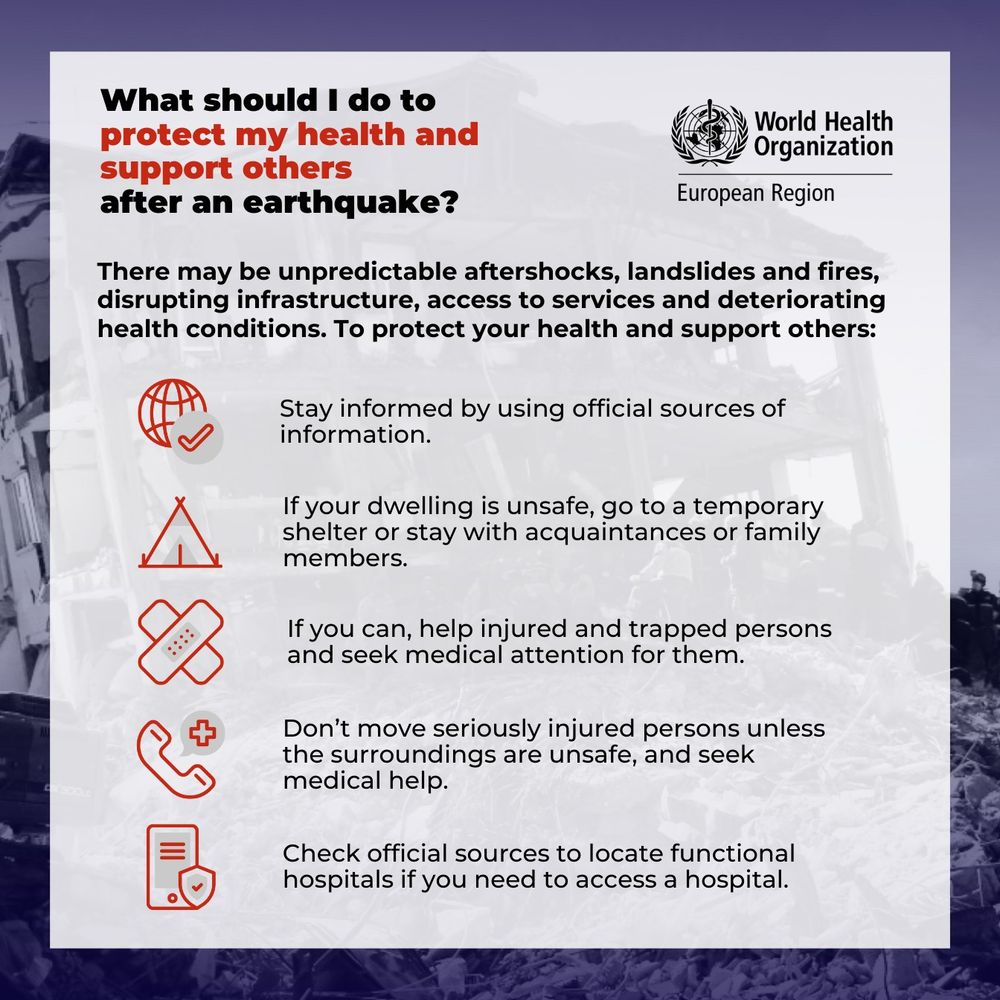
Line illustrations of what to do to protect your health and support others after an earthquake. Text reads there may be unpredictable aftershocks, landslides and fires, disrupting infrastructure, access to services and deteriorating health conditions. Stay informed by using official sources of information. If your dwelling is unsafe, go to a temporary shelter or stay with acquaintances or family members. If you can, help injured and trapped persons and seek medical attention for them. Don’t move seriously injured persons unless the surroundings are unsafe; seek urgent medical help. Check official sources to locate functional hospitals if you need to access a hospital
Know what to do after an earthquake to protect your health and support others.
#BePrepared
#StaySafe

Taking care of your mental health after a breast cancer diagnosis. Seek professional counseling for emotional support. Get physically active for your well-being. Stay committed to completing your treatment for the best chance of recovery. Practice stress management techniques. Focus on a balanced diet. Build a support network.
How do you take care of your #MentalHealth after a breast cancer diagnosis?
💟Seek professional help
💟Stay committed to completing your treatment plan
💟Practice stress management techniques
💟Focus on a balanced diet that supports your needs
💟Build a support network
💟Stay physically active if possible

On #WorldMentalHealthDay, we shine a light on mental health in humanitarian crises.
When homes are lost & families separated, recovery must include #MentalHealth care.
Let’s ensure support is part of every response—before, during & after crisis http://bit.ly/3KBMUcp